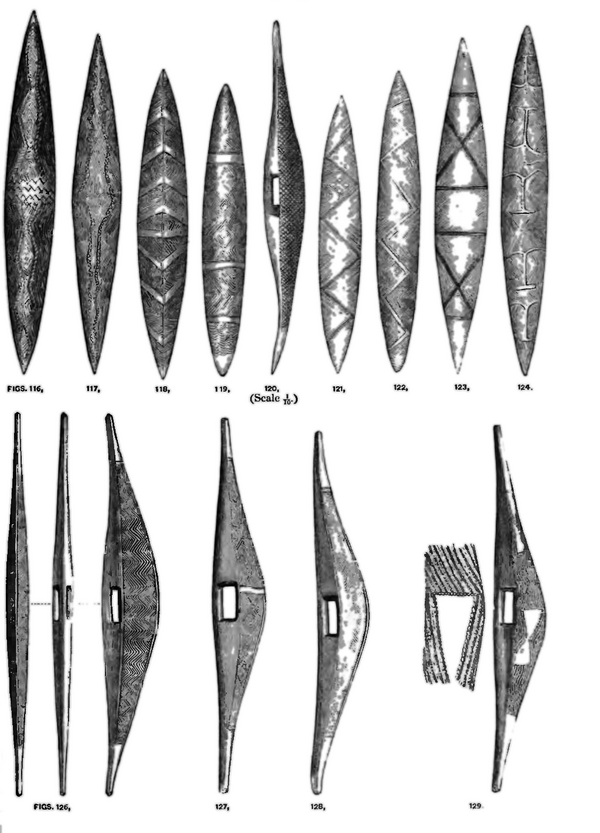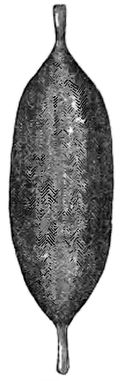The Aborigines of Victoria/Volume 1/Chapter 13
Of shields there are two kinds—the Mulga used for warding off blows given by the Kud-jee-run and Leon-ile, mostly in single combat, and the Gee-am for protection in a general fight against spears.

|
 |

| |
| FIG. 113, | 114, | 115. | |
| (Scale: 1⁄10.) |
Figs. 113, 114, 115 show the form of the Mulga, and one kind of ornamentation, and Figs. 116, 117, 118, 119, 120, 121, 122, 123, 124, 125, the usual modes of ornamentation of the front of the weapon. I have never seen a shield of this kind ornamented on the inner surfaces.
Of the several shields (Mulga) in my possession, none measures in length more than forty-one inches. The usual proportions are as follow:—Length, thirty -five inches; breadth, five inches; depth, about four inches; size of the aperture for the hand, from three to three and a half inches.
The wood preferred by the natives for making the Mulga is ironbark (Eucalyptus sideroxylon), but box (E. leucoxylon) is that most commonly used. Gum, peppermint, or Figs. 113, 114, 115. indeed any hard wood, is taken if the necessity is great.
Garrong (wattle-tree, Acacia mollissima) is not seldom employed for shields and other weapons.
Shields having an angular face-length from thirty to forty inches, a breadth of two inches, and a depth of five and a half inches, and ornamented in a similar manner to those already mentioned, are used by some tribes in the same manner as the ordinary Mulga.
Figs. 126, 127, 128, and 129 exhibit the form of these shields. A portion of Fig. 129 is enlarged, to show the style of ornamentation, which is altogether unusual in Victoria. Weapons of this shape are named Drunmung in the Western district.

This weapon is called Murgon by the natives of the Lower Murray, and Marr-aga by the natives of Gippsland.

|
| FIG. 125.–(Scale ⅓.) |

|
| FIG. 130. |
Probably for the purpose of preventing injury to the knuckles, it is customary to wrap around that part of the wooden shield grasped by the hand a piece of the skin of the opossum, as shown in Fig. 130. The Kul-luk and other instruments have the handles usually so covered, both for the protection of the hand, and to ensure a more secure hold of the weapon.
The Gee-am or Kerreem (spear-shield)—Figs. 131 and 132—is used in battle only, never in single combat.[1] Used skilfully, it protects all parts of the body from spears. Unless the point of a spear happens to strike the centre, which a skilful warrior by his movements makes almost impossible, it is impenetrable.
The usual dimensions are as follow:—Length, thirty-eight inches; greatest breadth, ten inches; and thickness rather more than a quarter of an inch.
It is made of the bark of the gum-tree. Binnap (manna gum-tree, Eucalyptus viminalis) is very often used.
In making these shields some skill is necessary. After the bark is taken from the tree, and rudely shaped in the form desired, a mound of earth is raised some three feet in length, and about the breadth of the bark; hot ashes are placed on the mound, the bark is laid thereon, and it is covered with heavy stones and sods. The green bark, by the time the ashes are cold, has taken the curve of the mound, and the finishing and ornamenting of the weapon are pursued at leisure. The natives of Lake Tyers call this shield Bam-er-ook.
 |

|
| FIGS. 131, | 132. |
| (Scale ⅛.) | |
 |

|
| FIGS. 133, | 134. |
| (Scale 1/10.) | |
In Figs. 131-2, 133-4 it will be seen that the handle—the inside length which is usually four inches—is not separated from, but forms a part of the weapon. Such instruments are now rare. In making them, the wood next to the bark and a part of the wood of the tree are used, and great art is necessary in cutting out the piece and perfecting the shape, so as to make the instrument strong and durable. In Figs. 135, 136, and 137 the handle is formed of a separate piece of wood, which, when green, is thrust into holes made to receive the ends. When finished, the handle can scarcely be taken out without breaking the weapon. These figures give different and very instructive examples of the modes of ornamentation in favor amongst the Aborigines.
 |
 |

|
| FIGS. 135, | 136, | 137. |
| (Scale 1/10.) | ||
The weight of a Gee-am is about one pound eleven ounces. Some are lighter, but seldom are any of them heavier.
Mr. George Bridgman, of Mackay, in Queensland, has sent me a very curious shield. The back, front, and sides are shown in the engraving. It is rudely but profusely ornamented, with shallow incised lines irregularly disposed, but so as to form a pattern.—(Fig. 138.) The two rows of shallow depressions marked with detached circles, at the top and bottom are colored red. The spaces at the ends are painted white. The back is nearly flat, and the handle is cut out of the solid wood. A figure, perhaps that of some reptile, is drawn on it, and colored white, and the spaces marked with incised lines are painted red. This shield is twenty inches and a quarter in length, and seven inches in breadth, and weighs only thirty-six ounces. The name of this shield at Mackay is Goolmarry.

|
| FIG. 139. |

|
| FIG. 138. |
The shield Fig. 139, from Rockingham Bay, Queensland, is a remarkable specimen of native art, and differs altogether from the shields in use in other parts of the continent. The form is an irregular oval. It is thirty-seven inches in length, and fifteen inches in width at the widest part. The thickness varies from one and a half to three inches. There is a boss or knob in the centre about three inches in length, an inch and a half in width, and about an inch in height. The whole is colored black, yellow, white, and red, in stripes and patches. The reverse is plain, and the handle is sunk in the wood. The wood of which it is made is very light.
Mr. A. J. Scott says that this shield is formed of the soft, light wood of the buttress root of a description of ficus, and that it is sometimes painted in blue, black, red, and yellow bands, in a quaint zig-zag pattern.
- ↑ The large wicker shield used by the Persians was called Gerrhum, and was shaped somewhat like the Assyrian Gerrha. (For an account of ancient shields see Rawlinson and Wilkinson.) Hence γερρον was the name amongst the Greeks for anything made of interlaced twigs, as the square shield made of osiers and the like. The similarity of names for the same kind of weapon is indeed strange.